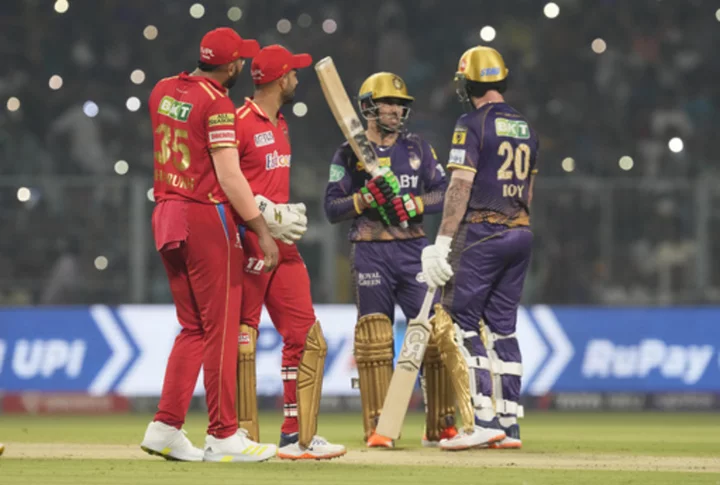While India has overtaken China as the world’s most populous nation and has perhaps grandiose ambitions of becoming a major international player, it has a long way to go to match its Asian neighbor’s clout in the sports arena.
China has won 283 Olympic gold medals, which is 273 more than India. China’s capital has hosted the Olympics twice: the Summer Games in 2008 and the Winter Games in 2022.
India has hosted the Asian Games and the Commonwealth Games but hasn’t yet staged the Olympics — although there’s the promise of an Indian bid for 2036.
“China has been successful on the tracks and fields of the world, India hasn’t,” Simon Chadwick, professor of sport and geopolitical economy at the SKEMA Business School in France, told The Associated Press. “India has underperformed.”
Except in cricket.
India’s overwhelming sporting success has been the development of the Indian Premier League, the world's richest and most dominant franchise cricket competition. And with that, India has created something China hasn't been able to achieve: a domestic league that is lucrative as well as internationally successful.
China's big plans to become a soccer powerhouse started with billions of dollars being spent on famous players and coaches from around the world, generating global headlines for the Chinese Super League for a decade until an economic downturn and then the COVID-19 pandemic changed everything.
Troubles in the property sector — particularly painful as more than half of the Chinese league's top-tier teams were owned by real estate companies — put an end to hopes that the league would rival the biggest in the world.
Instead, ambitions of the league being a launching pad for international success for China and its national team have been replaced by allegations of corruption and the financial problems that have resulted in several clubs folding, including defending champion Jiangsu FC in 2021.
Meanwhile the brand value of the India's Twenty20 cricket tournament, established in 2008, grew to an estimated $8.4 billion in 2022.
The IPL last year sold its five-year broadcasting rights for $6.02 billion, making it one of the most lucrative sports league in the world in terms of revenue per game, behind the NFL but above English soccer's Premier League.
“India is home to one of the most powerful sports properties in the world,” Chadwick said. “Which shows that the country has the resources and the expertise to successfully engage with sport.”
Arunava Chaudhuri, a sports consultant and former All India Football Federation media manager, said that needs to extend beyond cricket.
“The key is that India moves away from a one-sport country,” he said. “Success in badminton, wrestling, boxing has shown progress, but team sports are a different challenge."
Then there’s that talk of India bidding for the 2036 Olympics, with Chaudhuri saying the city of Ahmedabad “is being prepared for that.”
India’s Union Sports Minister Anurag Thakur told the Times of India newspaper in December that the government would support an Olympic bid and it would be prepared in time for important IOC meetings in Mumbai, which are being held in October.
“If India is putting in so much effort to promote sports, I can assure you that we will not only host the Olympics, we will host it in a big way,” Thakur told the newspaper. "This is the right time to host the Games. If India is making news in every sector from manufacturing to services, then why not in sports?”
Indian states such as Gujarat, home to the 132,000-seat Narendra Modi Stadium in Ahmedabad, and Odisha have taken the lead.
Dubbed as ‘India’s Sporting Capital’, Odisha state has invested more than $250 million to build stadiums for field hockey, tennis, badminton and aquatics. The Odishan city of Bhubaneswar hosted the field hockey World Cup in January and was one of six soccer venues for the women’s Under-17 World Cup last October.
“India is developing fast and might have an ambition to showcase its achievements through sports,” Ivanhoe Li, CEO of Beijing-based sports marketing company Fangze Sports, said. "Hosting a world-class event is not difficult but having great athletic performances might be a question.”
The U.N.’s Department of Economic and Social Affairs declared in April that India’s population was expected to reach 1.425 billion by the end of the month, surpassing mainland China’s population. It brought a lot of optimism in India, but China remains well established to pick up where it left off in 2020 sports.
CHINA BOUNCING BACK
China’s sports industry was hit by three years of stringent COVID-19 policies and a series of strict lockdowns which only ended in December, forcing a 12-month postponement of the 2022 Asian Games and Beijing relinquishing hosting rights for soccer’s 2023 Asian Cup.
That's something the Chinese want to put in the past. The country is ready to get back into the business of sports and the government has projected that the value of the sports industry would reach around $725 billion by 2025, a rise from $434 billion in 2021.
Li, the sports marketing expert, is optimistic about the future, fueled by a boom in the country after three years when hundreds of millions of people had to curb discretionary spending.
“Chinese people have a lot of money in the bank and the sports industry is picking up at an unexpected speed,” Li told AP. “The government is encouraging consumption in all sectors and while people are cautious of spending on property and automobiles, they are spending more on food, travel, health and sports.”
With a growing population, economy and political influence, India’s sports industry is making strides —- but still has some way to go to come close to China.
___
More AP sports: https://apnews.com/apf-sports and https://twitter.com/AP_Sports

